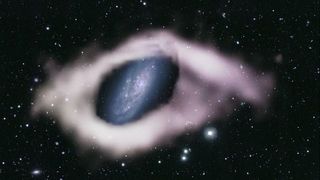A team of astronomers has discovered two new potential examples of a strange celestial object known as a polar ring galaxy. This elusive form of galaxy possesses a ring of stars and gas that's oriented 90 degrees to other stars in the realm as well as its main disk.
This result implies that so-called polar rings may not be as rare as scientists once suspected.
"Polar ring galaxies are some of the most spectacular looking galaxies in the universe," team co-leader and Queen’s University, Canada, researcher Nathan Deg said in a statement. "These findings suggest that one to three percent of nearby galaxies may have gaseous polar rings, which is much higher than suggested by optical telescopes."
The strange ring features of the two galaxies — NGC 4632, located around 56 million light years from Earth in the constellation of Virgo, and NGC 6156, located around 150 million light-years away in the constellation of Ara — are hidden in visible light. However, the features revealed themselves in radio observations.
Related: Globular cluster glitters in stunning new Hubble telescope photo
These strange galaxies are believed to form their rings of stars and gas during mergers in which a larger galaxy swallows a smaller one, with the gravitational influence of one galaxy dragging a stream of matter from the other. If polar ring galaxies are indeed more common than suspected, that means these cannibalistic mergers are also more frequent.
Studying the polar ring galaxies, which have been observed prior to this discovery, could also help scientists learn more about the haloes of dark matter that are believed to envelope galaxies while channeling the distribution of matter around them. Dark matter is a mysterious substance that accounts for around 85% of the matter in the universe but remains invisible to us.
As such, the findings could have significant implications for our understanding of how galaxies have grown and, in turn, how the universe has evolved.
The weird rings of stars and dust around NGC 4632 and NGC 6156 began to show up during an analysis of data gathered by the Australian Square Kilometre Array Pathfinder (ASKAP) located in Western Australia.
University of Manitoba scientist and member of the discovery team, Jayanne English, used optical and infrared data from the Subaru telescope to resolve the spiral disks of NGC 4632 and NGC 6156. English then used radio data from ASKEP’s Widefield ASKAP L-band Legacy All-sky Blind survey (WALLABY), which looked at the distribution of hydrogen gas around approximately half a million galaxies, to reveal the polar disks around them. That is when the team realized ASKAP had spotted polar ring galaxies for the first time.
"These results are a really nice illustration of the tremendous value of mapping the sky more deeply and more widely than has ever been done before," Kristine Spekkens, research co-leader and Queen’s University scientist, said in the statement. "This is serendipity at its best: we found things we certainly didn’t expect to find."
The composite images of the galaxies show details of their rings that human eyes would not be able to see, thanks to the incorporation of light beyond the visible light spectrum, such as radio light from cold hydrogen gas.
"We were able to work with data that showed a fine grid of velocity channels, which are equivalent to the radio stations on your old-fashioned radio receiver," English said. "The richness of the velocity data meant I could assign multiple colors to this composite to subtly convey the motion happening within the polar ring."
The color gradients within the rings show the different orbital motion of the gas, with purple regions at the disk’s base showing areas moving toward Earth, while white regions at the peak of the disk move away from us.
"The dance and choreography of the gas are beautiful, and that motion of the gas gives us some clues as to how galaxies evolve over time," English concluded.
The next step for the researchers will be to confirm that these are indeed polar ring galaxies by investigating NGC 4632 and NGC 6156 with a wide range of telescopes, including the MeerKAT radio telescope in South Africa.
The team’s findings were published Sept. 13 in the journal Monthly Notices of the Royal Astronomical Society.


